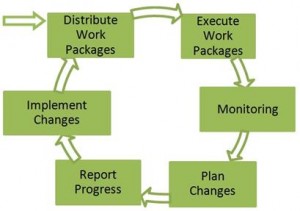
Project Execution and Monitoring: Getting the Work Done!
 On the page, “The Basic Project Management Process” I introduced project execution and monitoring as the third step of the basic project management process. This page expands on that information and follows on from “Project Planning: Will the Project Create Value?”
On the page, “The Basic Project Management Process” I introduced project execution and monitoring as the third step of the basic project management process. This page expands on that information and follows on from “Project Planning: Will the Project Create Value?”
The overall goal of the execution and monitoring phase of the project is to get the work done. This is the longest phase of the project. The execution and monitoring phase of a project typically takes several months and can even take several years to complete.
The steps in the execution phase are:
- Formally Start the Execution and Monitoring Phase
- Execution and Monitoring Cycle. This includes:
- Distribute the Work Packages
- Execute (work on) the Work Packages
- Monitor Progress
- Plan Changes
- Report Progress
- Implement Changes
Formally Start the Execution and Monitoring Phase
The Kick-Off Meeting
The ideal way to start the execution and monitoring phase of a project is with a kick-off meeting. The main goals of a kick-off meeting are to:
- Let everyone know that the project work is starting now
- Make sure everyone knows what the goal of the project is, and what their part is
- Introduce everyone to each other
- Motivate the project team
If a meeting is not possible, then a conference call or email could be used to introduce the project to the project team.
The Execution and Monitoring Cycle
The execution and monitoring cycle is core to being able to deliver a project. Below, the steps of the cycle are introduced:

Distribute the Work Packages
This should be self-explanatory. Any work packages, which could be started now, need to be distributed to the project team for them to work on.
Execute the Work Packages
Again, fairly obvious. The team works on the work packages that they have been given to do.
Monitoring
One of the main tasks that the project manager has to do is to monitor the progress of the project. The main areas to be checked are Time, Budget, Quality, and Risk.
| Time | Are the work packages completing on time? |
| Budget | Is there still enough money available to the project for the open work to be completed? |
| Quality | Is the project team able to deliver the expected level of quality? |
| Risk | Can any of the risks be closed because they are no longer relevant? Have any new risks been discovered that need to be accounted for? |
Plan changes
The purpose of the monitoring task above is to find any issues or problems, which the project team may have. Clearly, it is not enough to find the problems or issues. The expectation is, that an action will be planned to solve it as well!
Any changes, which need to be made to the project, either because the project team has found a problem or a better way of doing things, will need to be planned.
The steps for planning a change are similar to the steps taken during the project planning phase. Normally, there is no need to replan the whole project, just the part of the project affected by the change.
Report Progress
The reason that progress reporting comes after change planning, is that the project manager will need to agree the changes with the project sponsor. Progress reporting is a good time to get the support of the project sponsor for the change. The project manager can explain the current status, describe the planned change and expected improvement. The project sponsor is then in a good position to make a decision on the change request.
Implement Changes
The agreed changes can now be implemented by the project team.
Completing the Execution and Monitoring Phase
Once all the work packages have been completed, the project will move automatically into the closing phase of the project.
